

Dec 23, 2019Ontario growers cut corners for success
Gerbe Botden is a young apple grower who appreciates the benefits of modern orchard technology, such as Botden Orchards’ massive over-the-row recycling sprayer that towers over four rows.
The sprayer attracted immediate attention from a large tour group visiting the Ontario, Canada, farm last summer.
With all of the flashy production machinery on display – much of it conceived in the Thornbury, Ontario, Canada operation’s on-farm equipment and design shop – it was refreshing to see Botden take some visitors aside to a Red Prince orchard and talk about some basic, inexpensive tools he uses on a regular basis to chart the course toward an effective and profitable packout.
He shared how he uses lower-tech tools, including: A pocket knife, caliper, counting clicker, Equilifruit disk, soil tensiometer, a wireless data shuttle to record tensiometer levels and a jeweler’s loupe to scout for mites.
“We talked about the equipment over there, but without the tools to make the decisions, that equipment is useless unless you know how many fruit you have on the tree, how much extension growth you’ve got, what the soil moisture is like,” Botden said. “The tools I use every day include, when you’re thinning, you have to have a pocket knife to count how many seeds are on there to make sure everything is set properly in order to have equally sized fruit.”
“Later on, when you start measuring fruit, you have to have a digital caliper. We use the (precision apple thinning model other growers) have been using,” he said. “We haven’t used it the last couple of years, but it’s certainly taught me how the tree reacts to different stresses, different weather types, how the soil moisture has been. It makes it much easier to predict later on how the fruit’s going to react to the weather. If you watch the weather forecast, you’ll be able to make better management decisions.”
Just prior to the visit to the farm by the International Fruit Tree Association (IFTA) Summer Tour in July, Botden Orchards had completed its annual fruit count.
“We just finished our fruit count a little while ago,” Botden said. “I highly recommend a little counting clicker, especially when you’re talking on the phone trying to count fruit. It doesn’t hurt to walk through your own orchard rows. You can’t always do it from the truck and I really believe in that. I think that’s why (some growers in the area) have such nice orchards. They are always out there making sure that it looks good. They have the fruit numbers, fruit size, the soil moisture numbers that they need.
“Another good indicator for me is the equilifruit disk,” Botden said. “It tells you how many apples you can handle on a branch of a certain diameter. Of course, you have to adjust it depending on your variety or tree age.”
“It’s these indicators that let you manage the orchard effectively,” Botden said.
Botden said all of the farm’s orchards are fertigated.
“In the springtime, we’ll start with a nitrogen program making sure that our soil moistures are good,” he said. Botden uses a soil tensiometer, a measuring instrument used to determine the matric water potential (soil moisture tension) in the vadose zone. This device typically consists of a glass or plastic tube with a porous ceramic cup, and is filled with water.
“We use a soil tensiometers, measuring the tension in the soil,” Botden said. “They are connected to data logging stations. Once a week, we’ll go around with a data shuttle, stick a memory card in, and take the readings. There’s many different systems available, but this is fairly cheap and simple.
“My sister will go around and do the scouting, measure fruit and take soil moisture readings and then I can sit in front of the computer and make a good decision,” Botden said. “If I’m not sure, I will have to go out to the orchard and check it myself, but (he uses) something like this – to be able to see the graph and knowing the moisture is where it’s at when you need it. Especially in this orchard, where we’ve had 8 millimeters, or less than one-half an inch since the beginning of July, which isn’t going to do it for the trees to make the size that we need.”
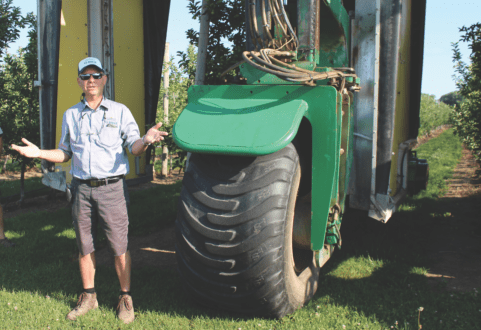

Botden’s father, Marius, was a nurseryman who immigrated to Canada in 2001. He explained how the labor crew has abandoned the use of picking bags from the harvest work and now pick directly into bins while using a platform and bin trailer. There are about 600 to 900 hours per season devoted to platform use.
Another strategy is to use a fully-enclosed cage for bins placed on a bin tractor trailer. It hauls 130 to 142 empty bins and 72 to 78 bins when full, stacked four high.
“We put more hours on (the platforms built off a hydrostatic Kioti tractor chassis) than our tractors,” Marius said. “On the whole farm we have just two picking ladders, and we always have to search for where they are.”
Changing with the times
Longtime grower Murray Porteous is phasing out involvement in his apple growing endeavor, but he had some tips for others undergoing farm transitions.
“With good management, we’ve been able to keep (some low-density plantings) profitable for a long time,” while attempting to maintain recent high-density plantings.
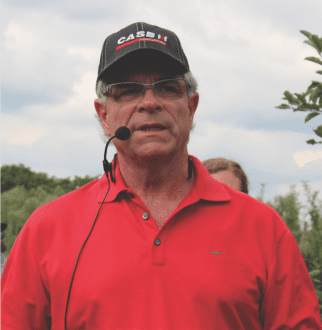

A 35-acre Wafler tip system has Gala and Ambrosia plantings on m.9 consists of 8-foot narrow rows on 13-foot wide rows.
“This is the last high-density planting we’ve planted,” Porteous said. “I really like this block. It’s in its third leaf. These were knipboom trees, Gala on m.9 predominately. There’s 42,000 Gala (trees) and 1,500 Ambrosia in this 35-acre block, planted eight feet between the narrow rows and 13 feet between the wide ones.
“We have pretty aggressive soil, so (planting) seven feet (as was viewed by Porteous’ son on an IFTA tour of Wafler’s in New York state) just made me really nervous, so we spread it out another foot to give us a little more room,” Porteus said. “Plus, we also didn’t want to buy any special equipment for this farm, just for 35 acres. So, it’s all of the equipment that we use on the other farms.
“With going eight feet, we kept the trees the same as what Wafler’s had, by moving the trees two inches closer together. The Gala are planted at 42 inches, and the Ambrosia are at 40 inches between trees, all planted with GPS,” he said. The posts lean out 16 inches from over the bottom to the top, about 9.5 feet.
“It’s a two-wire system,” Porteous said. “We put the bottom wire at 5.5 feet so we can pick everything every other row and not have problems getting between the trees, and in and out through the rows. We don’t like low wires for that reason. We want to be able to get around the trees and get out, and fill bins.
“It’s designed to be picked with a platform so the wider rows should be vertical when the trees have filled the space and the narrow rows would be on an angle,” he said. “We don’t take any equipment, other than a mower and a weed sprayer, down a narrow row. This is to be picked with a platform at the top when it’s in bearing.”
Porteous said the operators modified a Phil Brown weed sprayer “so we can get down the narrow rows without any problem with the John Deere tractor.”
Potential wind damage has raised concerns about tree stability, Porteous said.
“We’re concerned about trees maybe tipping over. We’ve got a post every 10 trees. On the end rows where we don’t have a cross wire going to another row, we put the posts closer to get a little bit more strength. We had a tornado come through this farm last year, and we didn’t lose a single tree. The trees are all wrapped on a wire. That’s to cut costs and get away from conduit. The theory is the wire will eventually cut into the tree and force branches up the trunk. Sometimes it’s hard to get branches to reestablish when you take the bigger ones out lower on the canopy, and hopefully it will help us with that.
“There were a 130-kilometer winds they figured going through this block and no trees were lost,” he said. “We did have a heck of a lot of hail in here. We had dime-sized crab apples where I counted 20 hail hits on an apple. It cut up the bark and the limbs really bad, and ripped some limbs. We went through and thinned the fruit off because the apples were cut in half and there was no way we could get enough fungicide on to protect them from getting pathogens on them, so they wouldn’t even make juice.”
The storm damage required a detailed approach.
“We really babied the trees last year and got them to grow decent,” Porteous said. “I’m pretty happy with how they came out of it. One big problem we had is once we had all of those injuries on the bark, black stem borer moved in. We lost a thousand trees last year and we’ve replaced another hundred this year.”
Multileader believer
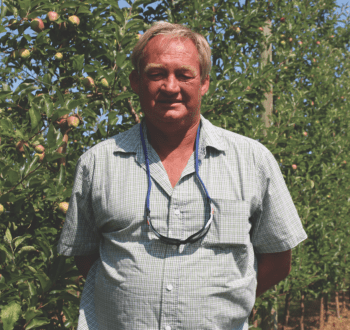

“I have 20 acres of my own down the road,” he told the IFTA visitors. “We farm 45 acres here of actual orchard. In 2007, we started planting super spindle; now we’re trying twin leader. We grow 40% Honeycrisp, with some Courtland, Ginger Gold, Goldens, Ambrosia and Gala. Average production for the last six years has been 37 bins an acre of fancy fruit, no processing. We try to grow high-end fruit for the fruit markets.
“I’m very fortunate,” Denbok said. “My father was a packer, so I was able in the 1980s to go to Europe every other year. If you think (multileader trees) is new, I saw this in the 80s, and it was more the UFO (upright fruiting offshoot) style than this.”
“If I can get a tree for $10, now I can get two trees for $10,” he said. After determining his cost to plant a super spindle system in 2007 was $50,000, he decided to explore multileader systems.
Gala was planted on m.9 rootstock with 30 inches between leaders. Rows were 12 feet apart in 2015. Another Gala block was planted in 2019 with m.26 multileader trees.
Seeking solutions
Shane Ardiel of Apple Springs Orchards planted his home farm in 1984 in a semi-drawf system. In 1996, he started planting his first high-density plot, 640 trees per acre, 5×14 on about 30 acres. In about 2006, Ardiel purchased the bottom part of father’s old farm.
“In 2010, we started planting Galas here,” Ardiel said. “Now, it’s mostly Honeycrisp, equal parts Ambrosia and Gala. We have some Crimson Crisp and some Salish.”
“At least 50 percent of our plantings are on b.9 or m.9,” Ardiel said.
Three years ago, the operation tried some Geneva 890s with Honeycrisp. The block had 2×11 spacing.
“We’re looking at 30 apples a tree, on the conservative side. With about 2,100 trees to the acre, we’re going to run maybe 30 bins to the acre with that.”
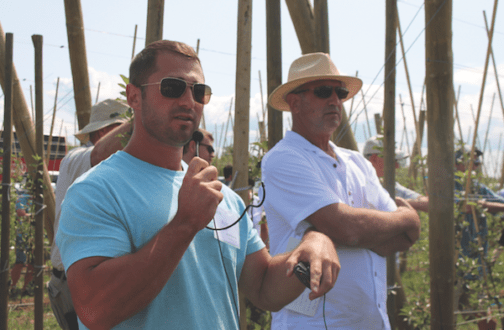

Shane’s son, Kyle, led an effort to see how Royal Red Honeycrisp on g.41 potted trees performed perform on a V-trellis system verses dormant planted B42 Honeycrisp on b.9 trees.
“They were a nightmare to plant,” Kyle Ardiel said. The trees were difficult to remove from the pot and would lose dirt and some roots.
The V trellis was pursued in an effort to encourage light interception, boosting the number of apples on the tree.
“Basically, I’m trying to determine the difference between g.41 Paula Reds, and a b.9 red strain of Honeycrisp,” Kyle Ardiel said. “I’m hoping I can get enough light penetration. I don’t want my branches to cross each other. One branch should be a foot from each tree. I’m going to try to get lots of windows in there.”
“This is one tree every foot, and then 11-foot spacing,” Kyle Ardiel said. “They are on 10-degree angles. Everything has been tape-gunned up with D-clips on the bottom. With trees in the ground, my costs are $50,000 to the acre. We’re going to try to aim for 80s and 88s. If I can get 50 apples on these trees once they are full grown, it should be close to 80-100 bins an acre, if you do the 4,000 trees at the 88 size.”
Small area, big results
Tom Ferri operates T&K Orchards with his wife Karen, brother Joe – a retired engineer who has come back to the farm – and a staff from Trinidad.
“It’s not big acreage here, but we try to make it very precise and make it work,” Tom Ferri said.
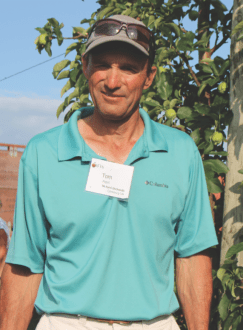

“We’ve been involved since about 2013 in the thinning program that Cornell (University) set up,” he said. “It’s worked well for us. We always were aggressive in chemical thinning, and this made us more aggressive as we sort of know where we’re at.
“We do things here a little different with Honeycrisp and Mutsu, Cortland and even McIntosh, he said. “We want apples that are 56s, 64s and 72s for the markets we have. Some will say you don’t get paid any for that, but we get paid a huge premium, especially for the Honeycrisp. They’re all stem-cut. They’re SmartFreshed and conditioned here before they go out. We try to get 80s, 88s and 100s with Gala. On Ambrosia, we can almost always get 80s and 88s. Gala, we struggle with.”
Tom and Joe Ferri have adopted Michigan State University Extension educator Phil Schwallier’s precision apple thinning spreadsheet.
The model works differently in the Georgian Bay region of Ontario, Ferri Orchards has found.
— Gary Pullano, managing editor














